Welcome back to guitarplayers.net! Today, we’re diving into a fundamental concept for every guitarist, from beginners strumming their first chords to seasoned players crafting their next hit song: the guitar riff. It’s surprising how often guitarists use terms like “riff” and “lick” interchangeably, or struggle to define them at all. If you’ve ever felt confused about what a guitar riff truly is, you’re definitely not alone.
Understanding the essence of a guitar riff is crucial. It’s not just a cool guitar part; it’s often the backbone of a song, its most recognizable and memorable element. Whether you’re composing your own music, learning your favorite tunes, or simply communicating musical ideas with other musicians, a clear grasp of riffs and licks is essential.
So, let’s cut through the confusion and get straight to the heart of the matter. What exactly is a guitar riff? And why is it so important?
 Close-up of a guitarist's hand playing a riff on an electric guitar, emphasizing the energetic and rhythmic nature of riffs.
Close-up of a guitarist's hand playing a riff on an electric guitar, emphasizing the energetic and rhythmic nature of riffs.
Defining the Guitar Riff: The Song’s Identity
Let’s be direct. A guitar riff is the DNA of a song. It’s a short, repeated musical phrase, often played on the guitar, that serves as a central building block and instantly recognizable hook. Think of it as the musical signature that defines a song’s character. Typically introduced early in a song, often right at the beginning, a riff sets the mood, grabs the listener’s attention, and establishes the song’s core identity.
Remember the legendary intro to Guns N’ Roses’ “Sweet Child O’ Mine”? That iconic melodic phrase, played by Slash, is a perfect example of a guitar riff. It’s instantly recognizable and inseparable from the song itself. That is the power of a guitar riff. It’s the musical idea that sticks in your head long after the song is over.
 A different angle of a guitar player focused on playing a complex riff, highlighting the skill and precision involved in riff playing.
A different angle of a guitar player focused on playing a complex riff, highlighting the skill and precision involved in riff playing.
The Importance of Guitar Riffs: Why They Matter
Riffs are more than just catchy guitar parts; they are fundamental to songwriting and musical impact. They transform a simple song into something truly memorable and impactful. A well-crafted riff acts as the thematic anchor of a song, instantly informing listeners what they’re about to experience.
Consider Led Zeppelin’s “Stairway to Heaven.” Imagine that song without its iconic opening riff. It simply wouldn’t be “Stairway to Heaven.” The intro riff is the song’s soul, its instantly recognizable invitation into a musical journey. Similarly, picture Deep Purple’s “Smoke on the Water” without that spine-tingling, powerful riff. The song would lose its punch, its iconic status, and much of its identity.
Throughout music history, countless guitarists have harnessed their creativity to forge riffs that have not only topped charts but have become timeless classics, resonating with generations of listeners. Riffs are the bedrock of countless hit songs across genres, particularly in rock, metal, and blues.
 A classic rock guitarist in action, playing a powerful riff during a live performance, conveying the energy and impact of guitar riffs in live music.
A classic rock guitarist in action, playing a powerful riff during a live performance, conveying the energy and impact of guitar riffs in live music.
Essential Guitar Riffs to Know
To truly grasp the impact of riffs, let’s explore some legendary examples that every guitarist should be familiar with:
- “Voodoo Child (Slight Return)” – Jimi Hendrix (A masterclass in psychedelic blues-rock riffing)
- “Beat It” – Michael Jackson (Eddie Van Halen’s iconic rock riff in a pop masterpiece)
- “Seven Nation Army” – The White Stripes (Simplicity and catchiness redefined in a modern classic)
- “Satisfaction” – The Rolling Stones (Fuzz-drenched and eternally rebellious)
- “Paranoid” – Black Sabbath (The blueprint for heavy metal riffs)
- “Whole Lotta Love” – Led Zeppelin (Blues-infused and powerfully dynamic)
- “Smoke on the Water” – Deep Purple (Simple, powerful, and instantly recognizable)
- “Back in Black” – AC/DC (High-energy and relentlessly driving)
- “Sweet Child O’ Mine” – Guns N’ Roses (Melodic and emotionally charged)
- “Enter Sandman” – Metallica (Heavy, rhythmic, and iconic in metal)
- “Smells Like Teen Spirit” – Nirvana (Grunge anthem with a simple yet unforgettable riff)
- “Walk This Way” – Aerosmith (Funky and hard-rocking crossover hit)
- “Layla” (Main Riff) – Derek and the Dominos (Bluesy and emotionally expressive)
- “Day Tripper” – The Beatles (Catchy and innovative for its time)
- “Iron Man” – Black Sabbath (Slow, heavy, and doom-laden)
This is just a starting point, of course. The world of guitar riffs is vast and diverse, spanning every genre and style imaginable.
Riffs: The Heart and Soul of a Song
In conclusion, a guitar riff is more than just a collection of notes. It’s the core musical idea, the defining phrase, and often the most memorable part of a song. It sets the tone, establishes the theme, and gives a song its unique identity. While riffs are commonly found in song introductions, they can appear throughout a song, adding punch and memorability wherever they’re placed.
Don’t be afraid to experiment and create your own riffs! They can be simple or complex, melodic or rhythmic, but the key is that they should be musically impactful and help define your song. And remember, riffs are rarely improvised; they are crafted, refined, and repeated to become an integral part of the song’s structure.
Now that we’ve explored riffs in detail, let’s turn our attention to guitar licks and understand how they differ.
 A guitarist's hand performing a fast guitar lick, showing the speed and technicality often associated with licks.
A guitarist's hand performing a fast guitar lick, showing the speed and technicality often associated with licks.
What is a Guitar Lick? Adding Spice and Flair
Now, let’s talk about guitar licks. No, we’re not talking about literally licking your guitar (though some rock stars might!). In musical terms, a guitar lick is quite different from a riff. While a riff is a foundational, repeating phrase, a guitar lick is a shorter, often more virtuosic, and typically improvised musical phrase.
Unlike a riff, which remains consistent and serves to establish the song’s main musical theme, a guitar lick is about variation and improvisation. Licks are often described by other terms like “solos,” “fills,” “runs,” or “phrases.” Regardless of the name, the defining characteristic of a lick is its flexibility and improvisational nature.
 A guitarist playing a lick during a solo, indicating the improvisational context and expressive nature of guitar licks.
A guitarist playing a lick during a solo, indicating the improvisational context and expressive nature of guitar licks.
The Purpose of Guitar Licks: Showcasing Skill and Improvisation
Guitarists often use licks to inject personality and flair into their playing, especially during solos. In live performances, the temptation to improvise and add unique touches is even stronger. Guitarists might alter existing solos, insert new flourishes, or play spontaneous, exciting phrases. These improvisations are, in essence, licks.
However, it’s important to note that not every improvisation qualifies as a “lick.” A true guitar lick is designed to be reusable and adaptable. It’s a musical idea that can be played repeatedly, but with slight variations each time, across multiple songs and musical contexts.
A guitarist might modify a lick by adding or removing notes, changing the rhythm, or altering other aspects to fit the moment. Because licks have a defined structure and musicality, they can be learned, practiced, and incorporated into your own playing to add that extra spark to solos and fills. Learning and mastering licks is a great way to expand your guitar vocabulary and improvisational skills.
Riffs vs. Licks: Key Differences Summarized
Let’s clearly outline the core differences between guitar riffs and licks:
| Feature | Guitar Riff | Guitar Lick |
|---|---|---|
| Purpose | Establishes song identity, thematic anchor | Adds flair, improvisation, showcases skill |
| Repetition | Repeated consistently, foundational | Varied, improvised, adaptable |
| Length | Can be short or longer phrase | Typically shorter phrase |
| Structure | Core structural element of a song | Ornamentation, soloing element |
| Improvisation | Rarely improvised, integral to composition | Often improvised, designed for variation |
| Instrumentation | Can be played on various instruments | Primarily guitar-specific |
| Memorability | Designed to be highly memorable, song-defining | Can be memorable but not always song-defining |
| Analogy | The icing on a cake – essential, defining | Sprinkles on a cake – decorative, enhancing but not essential |
Think of it this way: if a riff is the main course of a musical meal, a lick is the spice that enhances the flavor. Riffs provide the substance and structure, while licks offer embellishment and personal expression.
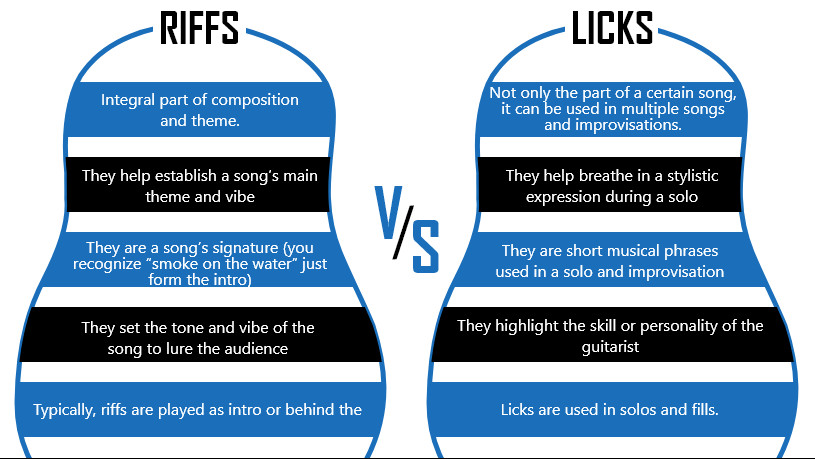 Infographic summarizing the key differences between guitar riffs and guitar licks, using visual elements to highlight the distinct characteristics of each.
Infographic summarizing the key differences between guitar riffs and guitar licks, using visual elements to highlight the distinct characteristics of each.
15 More Memorable Guitar Riffs You Need to Hear
Building on our earlier list, here are 15 more iconic guitar riffs that every aspiring guitarist should explore. Listening to these riffs and trying to play them is an incredible way to learn about songwriting, rhythm, and musical impact.
Visualizing these songs without their riffs can truly highlight just how crucial the riff is to each song’s identity and success. Get ready to expand your musical horizons and discover some truly legendary guitar work.
 A collection of vinyl records featuring albums with iconic guitar riffs, visually representing the vast history and influence of guitar riffs in music.
A collection of vinyl records featuring albums with iconic guitar riffs, visually representing the vast history and influence of guitar riffs in music.
Note: This list is in no particular order.
- “Brianstorm” – Arctic Monkeys (Modern indie rock energy with a driving riff)
- “Johnny B. Goode” – Chuck Berry (Rock and roll classic, the archetype of a guitar riff)
- “Sunshine of Your Love” – Cream (Psychedelic blues-rock with a wah-drenched riff)
- “One” – Metallica (Dynamic and emotionally powerful metal ballad riff)
- “Pretty Vacant” – Sex Pistols (Punk rock energy and raw simplicity)
- “I Wanna Be Your Dog” – The Stooges (Proto-punk aggression and minimalist riffing)
- “I Can’t Explain” – The Who (Power chords and driving energy from rock pioneers)
- “Cinnamon Girl” – Neil Young (Simple, melodic, and folk-rock infused)
- “Don’t Cry” – Guns N’ Roses (Melancholic and emotionally resonant ballad riff)
- “Marquee Moon” – Television (Angular and art-punk influenced riffing)
- “Get It On” – T. Rex (Glam rock stomp and swagger)
- “Alive” – Pearl Jam (Grunge anthem with a soaring and anthemic riff)
- “You Really Got Me” – The Kinks (Raw power chords and British Invasion energy)
- “Purple Haze” – Jimi Hendrix (Fuzzy, psychedelic, and groundbreaking)
- “Walk” – Pantera (Heavy metal groove and aggression)
Beginner-Friendly Guitar Riffs to Learn at Home
Ready to put your knowledge into practice? Let’s dive into some beginner-friendly guitar riffs that you can learn and experiment with right away. These riffs are designed to be accessible to players at any level, so grab your guitar and get ready to riff!
Remember, these are starting points. Feel free to modify them, adapt them to your own style, and even use them as inspiration for your own original songs.
 A beginner guitarist practicing riffs at home, showing the accessible and practical nature of learning guitar riffs for skill development.
A beginner guitarist practicing riffs at home, showing the accessible and practical nature of learning guitar riffs for skill development.
Power Chord Guitar Riff
Power chords are a staple of rock and roll, and this riff is a great way to practice them while creating a solid, driving sound. Palm muting (dampening the strings with the side of your picking hand) adds extra punch and heaviness, but don’t worry if you’re not familiar with it yet – the riff works great without it too!
E|-------------------------------------------------|
B|-------------------------------------------------|
G|-------------------------------------------------|
D|-2-2-2-2-2-2-2-2-5-5-5-5-5-5-5-5-7-7-7-7-7-7-7-7-|
A|-2-2-2-2-2-2-2-2-5-5-5-5-5-5-5-5-7-7-7-7-7-7-7-7-|
E|-0-0-0-0-0-0-0-0-3-3-3-3-3-3-3-3-5-5-5-5-5-5-5-5-|Chords: E5, A5, D5
This riff pattern is versatile and can be used in various parts of a song, including verses or choruses. Experiment with different rhythms and tempos to make it your own!
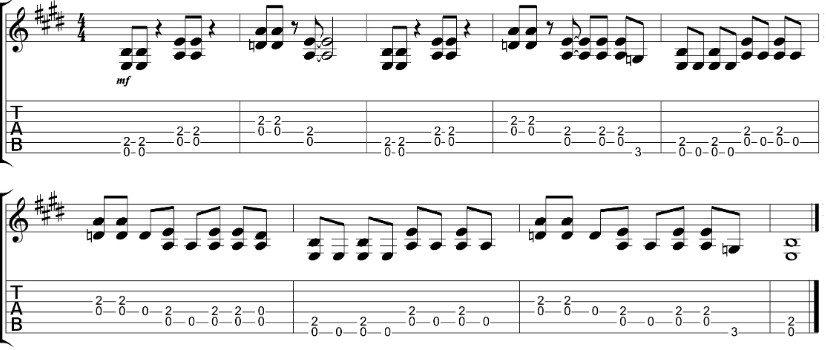 Guitar tab for a power chord riff, visually representing the notes and chords for beginner guitarists to learn.
Guitar tab for a power chord riff, visually representing the notes and chords for beginner guitarists to learn.
Funky Clean Guitar Riff
Time to get funky! This clean guitar riff is perfect for practicing your rhythm and adding a groove to your playing. Using your thumb on your fret hand to fret the lower strings (neck-hand thumb technique) can help with muting and create a tighter, funkier sound.
e|-------------------------------------------------|-------------------------------------------------|
B|-------------------------------------------------|-------------------------------------------------|
G|-------------------------------------------------|-------------------------------------------------|
D|-------------------------------------------------|-------------------------------------------------|
A|-7-7-7-7-7-7-7-7-5-5-5-5-5-5-5-5-----------------|-9-9-9-9-9-9-9-9-7-7-7-7-7-7-7-7-----------------|
E|-5-5-5-5-5-5-5-5-3-3-3-3-3-3-3-3-----------------|-7-7-7-7-7-7-7-7-5-5-5-5-5-5-5-5-----------------|Chords: E7 (implied), D7 (implied), G7 (implied), C7 (implied)
This riff is designed to be repeated throughout verses, creating a rhythmic foundation for your song. Try transposing it to different keys and experimenting with different chord voicings.
 Guitar tab for a funky clean guitar riff, illustrating a different style of riff with cleaner tones and rhythmic complexity.
Guitar tab for a funky clean guitar riff, illustrating a different style of riff with cleaner tones and rhythmic complexity.
Acoustic Guitar Riff
Acoustic guitars are riff machines too! This example demonstrates a short but effective acoustic riff perfect for intros or instrumental breaks. It’s all about setting the mood and tempo right from the start.
 An acoustic guitar player demonstrating an acoustic riff, highlighting the versatility of riffs across different guitar types.
An acoustic guitar player demonstrating an acoustic riff, highlighting the versatility of riffs across different guitar types.
e|-------------------------------------------------|-------------------------------------------------|
B|-------3-----------3-----------3-----------3-----|-------3-----------3-----------3-----------3-----|
G|-----0---0-------0---0-------0---0-------0---0---|-----0---0-------0---0-------0---0-------0---0---|
D|---2-------2---2-------2---2-------2---2-------2-|---0-------0---0-------0---0-------0---0-------0-|
A|-3-----------3-----------3-----------3-----------|-2-----------2-----------2-----------2-----------|
E|-------------------------------------------------|-------------------------------------------------|This riff, while simple, creates a beautiful and engaging intro. Focus on clean fingerpicking or a light strumming technique to bring it to life.
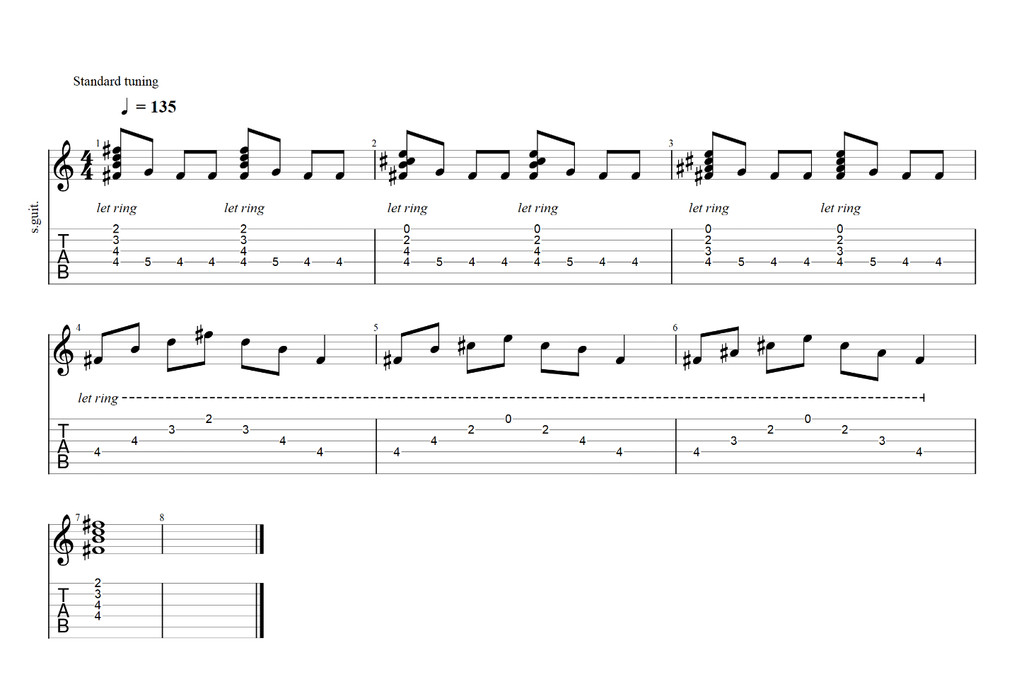 Guitar tab for an acoustic guitar riff, showcasing fingerpicking patterns and melodic phrasing suitable for acoustic guitars.
Guitar tab for an acoustic guitar riff, showcasing fingerpicking patterns and melodic phrasing suitable for acoustic guitars.
Guitar Licks to Elevate Your Playing
Now that we’ve explored riffs, let’s shift our focus to guitar licks. Here are a couple of licks inspired by guitar legends that you can learn to add some serious flair to your playing.
 A guitarist shredding a fast lick on an electric guitar, emphasizing the exciting and virtuosic aspects of guitar licks.
A guitarist shredding a fast lick on an electric guitar, emphasizing the exciting and virtuosic aspects of guitar licks.
Lick in the Style of Joe Satriani
Joe Satriani is a master of guitar technique and melodic phrasing. This lick captures some of his signature style, incorporating techniques that might be a bit more advanced but are definitely achievable with practice. Don’t be discouraged if it takes time to master – the payoff is worth it!
e|-------------------------------------------------|-------------------------------------------------|
B|-------------------------------------------------|-------------------------------------------------|
G|-------------------------------------------------|-------------------------------------------------|
D|-------------------------------------------------|-------------------------------------------------|
A|-5-7-8-7-5---5-7-8-7-5---5-7-8-7-5---5-7-8-7-5---|-3-5-6-5-3---3-5-6-5-3---3-5-6-5-3---3-5-6-5-3---|
E|-----------8-----------8-----------8-----------8-|-----------6-----------6-----------6-----------6-|
e|-------------------------------------------------|
B|-------------------------------------------------|
G|-------------------------------------------------|
D|-------------------------------------------------|
A|-1-3-4-3-1---1-3-4-3-1---1-3-4-3-1---1-3-4-3-1---|
E|-----------4-----------4-----------4-----------4-|This lick emphasizes legato playing (smooth, connected notes) and melodic contour, hallmarks of Satriani’s style. Practice slowly and focus on accuracy and fluidity.
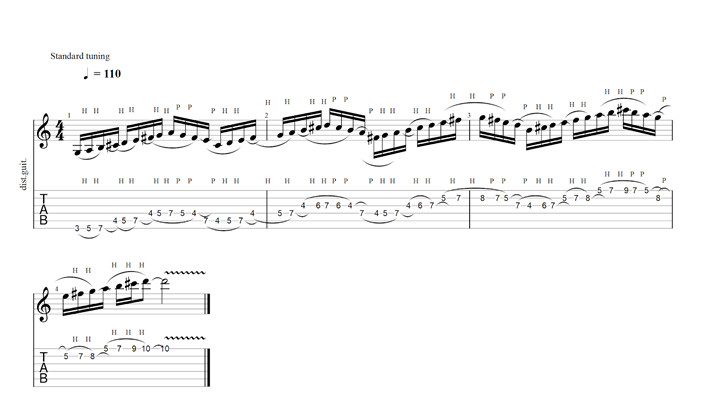 Guitar tab for a Joe Satriani-style lick, showcasing more advanced techniques and melodic phrasing inspired by a guitar virtuoso.
Guitar tab for a Joe Satriani-style lick, showcasing more advanced techniques and melodic phrasing inspired by a guitar virtuoso.
Lick in the Style of Wes Montgomery
Wes Montgomery was a jazz guitar legend known for his unique thumb-picking technique and improvisational genius. This lick captures a taste of his signature style, blending smooth melodic lines with jazzy phrasing.
e|-------------------------------------------------|-------------------------------------------------|
B|-8-10-11-10-8---8-10-11-10-8---8-10-11-10-8---8-|-6-8-9-8-6---6-8-9-8-6---6-8-9-8-6---6-8-9-8-6---|
G|---------------10--------------10--------------10|-------------8-------------8-------------8-----|
D|-------------------------------------------------|-------------------------------------------------|
A|-------------------------------------------------|-------------------------------------------------|
E|-------------------------------------------------|-------------------------------------------------|
e|-------------------------------------------------|
B|-4-6-7-6-4---4-6-7-6-4---4-6-7-6-4---4-6-7-6-4---|
G|-------------6-------------6-------------6-----|
D|-------------------------------------------------|
A|-------------------------------------------------|
E|-------------------------------------------------|This lick emphasizes smooth, melodic lines and a jazzy feel. Focus on using your thumb or fingerpicking to create a warm, rounded tone.
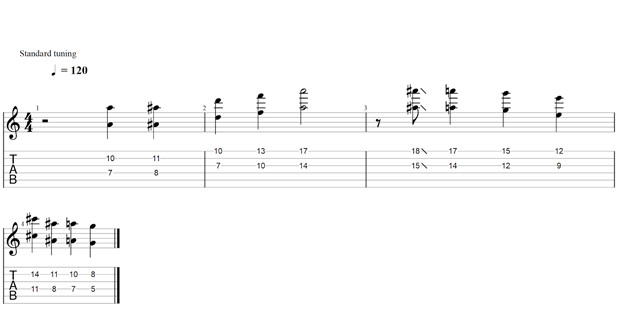 Guitar tab for a Wes Montgomery-style lick, demonstrating jazz-influenced phrasing and a different approach to guitar licks.
Guitar tab for a Wes Montgomery-style lick, demonstrating jazz-influenced phrasing and a different approach to guitar licks.
Your Journey into Riffs and Licks Starts Now!
You’ve now unlocked the essential differences between guitar riffs and licks and explored a range of examples to get you started. The best way to truly understand and master these concepts is to keep practicing, keep listening to your favorite guitarists, and keep experimenting!
Want to take your guitar playing even further? My book, “Soloing Techniques For Beginners,” is packed with even more riffs, licks, techniques, and exercises to help you become a more confident and creative guitarist. With over 100 licks and riffs, many inspired by guitar legends, you’ll have a wealth of material to learn and practice for months to come.
Ready to dive deeper? Shop now and unleash your guitar potential!
[
